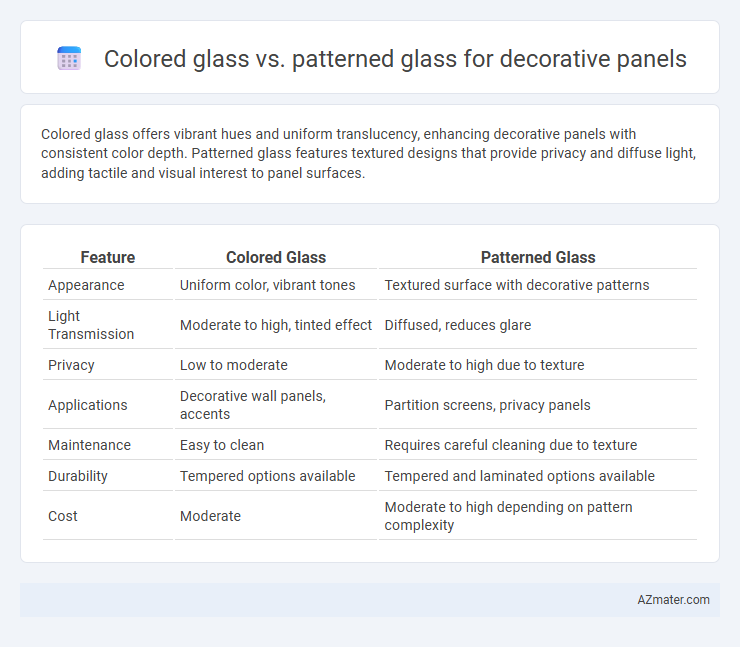Colored glass offers vibrant hues and uniform translucency, enhancing decorative panels with consistent color depth. Patterned glass features textured designs that provide privacy and diffuse light, adding tactile and visual interest to panel surfaces.
Table of Comparison
| Feature | Colored Glass | Patterned Glass |
|---|---|---|
| Appearance | Uniform color, vibrant tones | Textured surface with decorative patterns |
| Light Transmission | Moderate to high, tinted effect | Diffused, reduces glare |
| Privacy | Low to moderate | Moderate to high due to texture |
| Applications | Decorative wall panels, accents | Partition screens, privacy panels |
| Maintenance | Easy to clean | Requires careful cleaning due to texture |
| Durability | Tempered options available | Tempered and laminated options available |
| Cost | Moderate | Moderate to high depending on pattern complexity |
Introduction to Decorative Glass Panels
Decorative glass panels enhance interior and exterior spaces by combining aesthetic appeal with functionality, using materials like colored glass and patterned glass to achieve vibrant or textured effects. Colored glass panels infuse environments with rich hues through pigments or laminates, while patterned glass provides depth and privacy via etched or embossed designs. These options allow designers to customize lighting, ambiance, and visual interest in residential and commercial applications.
Overview of Colored Glass
Colored glass for decorative panels offers vibrant hues achieved through metal oxides or dyes during production, ensuring long-lasting, fade-resistant color that enhances interior aesthetics. It provides uniform coloration and smooth texture, allowing for seamless integration into various design themes such as modern, retro, or artistic environments. Compared to patterned glass, colored glass delivers a consistent visual appeal without surface texturing, making it ideal for striking color effects and light filtration.
Overview of Patterned Glass
Patterned glass features textured surfaces created through rolling that enhance privacy and diffuse light, making it ideal for decorative panels in both residential and commercial spaces. Common patterns include reed, rain, and hammered textures, each offering unique aesthetic and functional benefits by obscuring visibility while allowing natural illumination. Unlike colored glass, patterned glass emphasizes texture and light manipulation over pigmentation, providing versatile design options that complement various architectural styles.
Aesthetic Appeal: Color vs. Pattern
Colored glass enhances decorative panels by offering vibrant, uniform hues that create a bold, modern aesthetic. Patterned glass contributes intricate designs and textures, adding visual depth and subtle complexity to interior spaces. Choosing between colored and patterned glass depends on the desired impact: vivid color saturation versus elegant surface detail in decor.
Light Transmission and Privacy Comparison
Colored glass offers moderate light transmission with vibrant hues that diffuse sunlight, enhancing privacy by obscuring clear views while maintaining brightness. Patterned glass varies in light transmission depending on design intricacy, often providing higher privacy through textured surfaces that distort visibility without significantly reducing natural light. Both options balance aesthetics and function, with colored glass emphasizing color richness and patterned glass prioritizing visual privacy through surface manipulation.
Durability and Maintenance Considerations
Colored glass for decorative panels offers high durability due to its uniform pigmentation, which resists fading and surface scratches over time, making it ideal for long-term use. Patterned glass, while aesthetically versatile, may require more frequent cleaning to maintain clarity as its textured surfaces can trap dust and debris more easily. Maintenance for colored glass typically involves simple wiping with non-abrasive cleaners, whereas patterned glass might demand specialized care to preserve both its texture and appearance.
Customization Options and Design Flexibility
Colored glass offers a wide spectrum of solid hues and gradients, allowing for precise color customization in decorative panels to match specific interior design themes. Patterned glass provides intricate textures and motifs, enhancing privacy while enabling creative light diffusion and artistic effects. Both options deliver strong design flexibility, with colored glass excelling in bold color statements and patterned glass offering nuanced visual interest through surface designs.
Application Areas: Where Each Glass Excels
Colored glass is ideal for applications requiring vibrant aesthetics, such as feature walls, artistic installations, and custom cabinetry, where its rich hues enhance visual impact and create striking focal points. Patterned glass excels in privacy-focused areas like office partitions, bathroom panels, and conference rooms, providing texture and obscurity while allowing light transmission. Both types serve well in decorative panels, but colored glass is preferred for bold color statements, whereas patterned glass suits environments prioritizing privacy and diffused light.
Cost Analysis: Colored vs. Patterned Glass
Colored glass panels typically present a higher upfront cost due to the use of pigments and specialized manufacturing processes, while patterned glass may offer a more cost-effective solution by utilizing texture and embossing techniques without extensive coloration. Maintenance and replacement expenses for colored glass often remain stable over time, whereas patterned glass can incur additional costs if the embossed patterns wear or chip. When evaluating budgets for decorative panels, the choice between colored and patterned glass should factor in initial investment, durability, and long-term upkeep to optimize overall expenditure.
Choosing the Right Glass for Your Decorative Panels
Colored glass offers vibrant hues and uniform transparency, enhancing decorative panels with bold, consistent color schemes ideal for modern or artistic spaces. Patterned glass provides textured designs that diffuse light, adding privacy and intricate visual interest while maintaining natural illumination. Selecting between colored and patterned glass depends on whether the priority is vivid color impact or subtle texture and light manipulation in the panel design.

Infographic: Colored glass vs Patterned glass for Decorative panel
 azmater.com
azmater.com